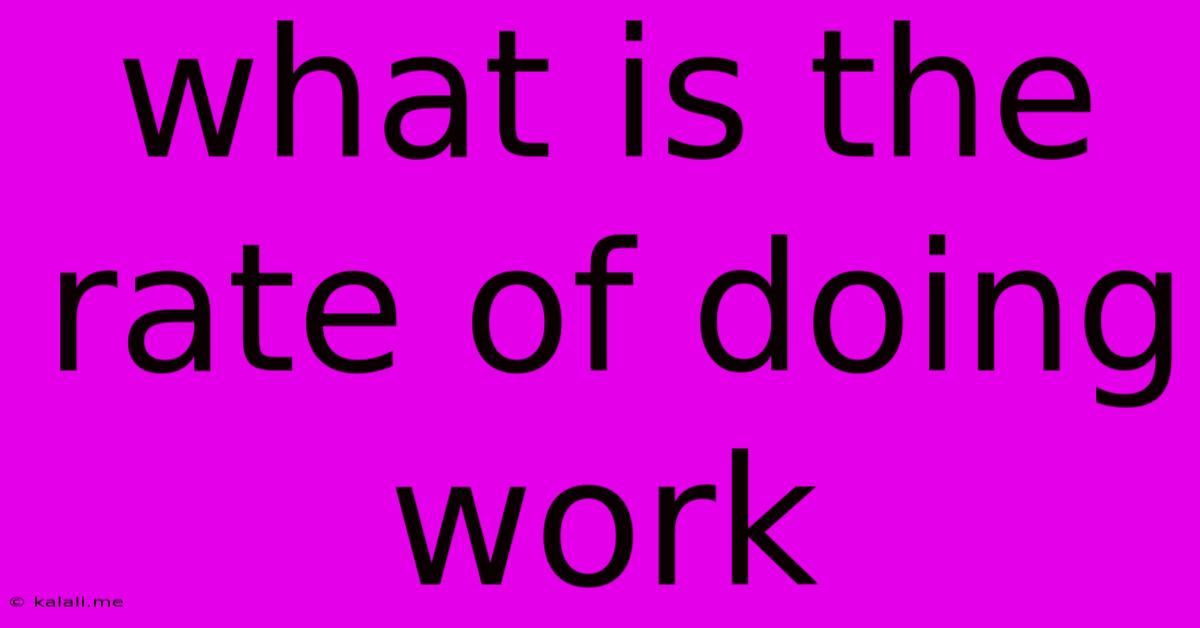What Is The Rate Of Doing Work
Kalali
Jun 13, 2025 · 3 min read

Table of Contents
What is the Rate of Doing Work? Understanding Power and its Applications
The rate of doing work is a fundamental concept in physics, commonly known as power. Understanding power is crucial in various fields, from engineering and mechanics to everyday life. This article will delve into the definition of power, its units, formulas, and practical applications, equipping you with a comprehensive understanding of this important concept. We'll explore various examples to illustrate its relevance and provide you with the knowledge to calculate power in different scenarios.
Power essentially measures how quickly work is done or energy is transferred. It's not just about the amount of work accomplished, but the speed at which it's accomplished. A powerful engine, for instance, can perform the same amount of work as a less powerful engine, but it does so much faster.
Defining Power: Work Done per Unit Time
The most straightforward definition of power is the rate at which work is done. Mathematically, it's expressed as:
Power (P) = Work (W) / Time (t)
Where:
- P represents power, typically measured in watts (W).
- W represents work, measured in joules (J).
- t represents time, measured in seconds (s).
Therefore, one watt is equivalent to one joule of work done per second. This means a 100-watt light bulb consumes 100 joules of energy every second.
Alternative Formula: Power and Energy
Since work and energy are interchangeable terms in many contexts, we can also express power in terms of energy transfer:
Power (P) = Energy (E) / Time (t)
This formula is particularly useful when dealing with energy sources like electricity or heat, where the concept of "work" might not be as directly applicable.
Units of Power
The standard unit for power is the watt (W), named after the Scottish engineer James Watt. Other units, often used for larger power values, include:
- Kilowatt (kW): 1 kW = 1000 W
- Megawatt (MW): 1 MW = 1,000,000 W
- Gigawatt (GW): 1 GW = 1,000,000,000 W
- Horsepower (hp): This is an older unit of power, often used in the context of engines. 1 hp ≈ 746 W
Examples of Power in Action
Let's consider some practical examples to solidify our understanding:
-
Lifting a weight: Imagine lifting a heavy box. The power involved depends on both the weight of the box (work done against gravity) and the time taken to lift it. Lifting the same box quickly requires more power than lifting it slowly.
-
A running car engine: A car engine's power output dictates its acceleration and top speed. A more powerful engine can accelerate faster and reach higher speeds because it can do more work (overcoming friction and air resistance) in less time.
-
Electrical appliances: The wattage rating of appliances (like light bulbs, heaters, or computers) indicates their power consumption. A higher wattage means a greater rate of energy consumption.
-
Human power: Even human activities involve power. Running up a flight of stairs requires more power than walking up slowly because the same amount of work is done in less time.
Calculating Power: Practical Applications
Calculating power is straightforward using the formulas provided. For example, if a machine performs 5000 joules of work in 10 seconds, its power is:
P = 5000 J / 10 s = 500 W
This simple calculation showcases the practical application of understanding power in various fields. From designing efficient machines to understanding the energy consumption of household appliances, the rate of doing work—power—plays a critical role in our technological world. Mastering this concept is key to appreciating the dynamics of energy and work in countless applications.
Latest Posts
Latest Posts
-
Which Of The Following Is A Connectionless Protocol
Jun 14, 2025
-
Cooling Of Magma On Earths Surface
Jun 14, 2025
-
Relation Between Linear Acceleration And Angular Acceleration
Jun 14, 2025
-
Which Of The Following Statements About Government Is True
Jun 14, 2025
-
What Type Of Electromagnetic Wave Has The Longest Wavelength
Jun 14, 2025
Related Post
Thank you for visiting our website which covers about What Is The Rate Of Doing Work . We hope the information provided has been useful to you. Feel free to contact us if you have any questions or need further assistance. See you next time and don't miss to bookmark.